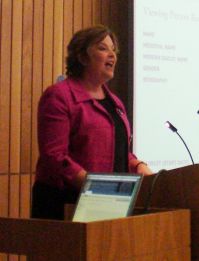Medieval Scottish History webpages launched
Published: 11 September 2009
A new web-resource for Scottish History, which aims bring the latest research on a pivotal period in Scotland’s past to the widest possible audience, has been launched.
A new web-resource for Scottish History, which aims bring the latest research on a pivotal period in Scotland’s past to the widest possible audience, has been launched.
The website - www.poms.ac.uk - has been produced by the Glasgow-led AHRC-funded project, ‘The Paradox of Medieval Scotland, 1093-1286’ which also includes researchers from Edinburgh and King’s College, London.
Professor Dauvit Broun, the Principal Investigator, University of Glasgow said: “One of the main reasons that the project focuses on the 12th and 13th centuries is that this is the period when ‘Scotland’ and ‘Scots’ first began to mean what it does today. By the end of the period it seems to have been taken for granted by the king’s subjects that the kingdom consisted of a single country - Scotland stretching north from the Tweed and Solway - whose inhabitants were a single people - the Scots. At the beginning of the period this would have been unthinkable. At that time the king was thought of as ruling a number of regions and peoples. In David I’s day ‘Scotland’ typically meant only the historic core north of the Forth and south of Moray. The ‘Scots’ in this context were only the inhabitants of that region. 
“The way Scotland and Scots came to be so radically redefined in this period, and became something that we can recognise today, cannot be explained simply by the deeds of powerful men. Its secret lies in the history of the people at large who created this new identity for themselves. The ‘Paradox’ is that, at the same time, Scotland was becoming more English. Government, church, economy, law, language and culture became much closer to England than before. The result was not simply an extension of England in the north. Instead, this new identity was connected umbilically to a self-conscious awareness of Scotland’s status as an independent kingdom.”
The web resource offers a preliminary sketch of this period - the Historical Introduction - and the exploration of some points of interest in the ‘Feature of the Month’ by the two researchers based at the University of Glasgow, Dr Amanda Beam and Dr John Reuben Davies. By the end of the project it will also give access to in-depth studies of charters and Gaelic names. The investigation of Gaelic names will benefit enormously from the contribution of Professor Roibeard Ó Maolalaigh, Professor of Gaelic at Glasgow, a Co-Investigator in the project.
The most exciting part of the website, however, will be the multi-faceted database containing information on everyone mentioned in more than 6000 documents from Scotland between 1093 and 1286. It will show not only who they were, but will give an insight into how they related to each other as individuals, as different parts of society, and as Gaels and non-Gaels. A prototype of the database will be publicly available from the beginning of 2010, and it will be finalised in August 2010 when the project ends. Not only is Scotland one of the most interesting examples of how a national identity was born, but historians at large - not just scholars across the world but anyone with an interest in Scottish history - will, through the database, be able to study the people of a medieval kingdom in unprecedented detail.’
Fiona Hyslop, Cabinet Secretary for Education and Lifelong Learning, launched the new web-resource for Scottish History at an event held on 8 September in the Informatics Forum at the University of Edinburgh, attended by academics, archivists, librarians, teachers, and school students.
Further information:
Martin Shannon, Media Relations
University of Glasgow Tel: 0141 330 8593
First published: 11 September 2009
<< September

